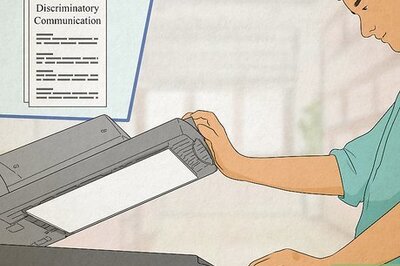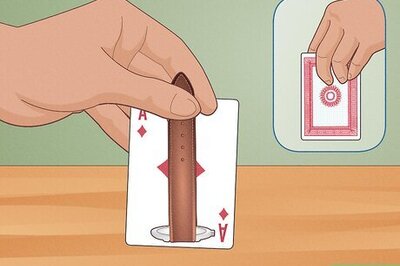
views
Weighing the Propane Tank to Tell if It’s Empty
Turn off the propane tank and disconnect it from your appliance. Turn the valve on top of the tank clockwise (right) to shut off the flow of propane. Then, turn the connector knob counterclockwise (left) to disconnect the tank from your grill (or whichever appliance it’s attached to). Warning: Propane is highly flammable. Make sure your grill or appliance is completely shut off and unplugged before disconnecting the propane tank.
Find the tare weight on the handle of the tank. All propane tanks are printed with the tare weight, labeled “TW,” on the side of the handle. The tare weight is the weight of the tank when it’s empty. You might see another number on the handle labeled “WC,” which is the tank’s water capacity. You don’t need this number to estimate how much propane is left.
Weigh your propane tank on a scale. Place the propane tank on a bathroom scale. Then, write down the weight of the tank.
Subtract the tare weight from the tank’s weight. To see how much propane is left, subtract the tank’s tare weight from the tank’s total weight that you just measured. This provides you with an estimate of how many pounds (kg) of propane are left in the tank. For example: If your tank’s tare weight is 18 lbs (8 kg) and its total current weight is 25 lbs (11 kg), subtract 18 from 25 to get 7. So, there are about 7 lbs (3 kg) of propane left in the tank. Note: Weighing your tank just gives you an estimate of how much propane is left, not an exact amount.
Using Hot Water to Tell if a Propane Tank is Empty
Shut off the propane tank and then disconnect it. Twist the valve on top of the propane tank all the way to the right (clockwise) to turn off the propane flow. Then, twist the connector knob to the left (counterclockwise) to disconnect the tank from the appliance it’s attached to. Warning: Turn off and unplug your grill or other appliance before disconnecting the propane tank. Propane is highly flammable.
Pour hot water onto the tank and find where it feels cool. Fill a jug or bucket with hot water and pour it down the side of the tank. Then, press your hand against the side of the tank to see where it changes from feeling warm to cool. All the cool area below the transition line is the amount of propane left in the tank. Propane absorbs heat, so the outside of the tank feels cool wherever the propane is. The outside of the tank feels warm wherever there is just air inside the tank. If the propane fill level feels low in the tank, it’s likely time to get a refill. Note: The water test only gives you a rough estimate of how much propane is left in the tank; it is not a precise measurement.
Installing a Pressure Gauge to Tell if a Propane Tank is Empty
Turn off and then disconnect the propane tank. Close the valve on top of the tank by turning it clockwise (right); this shuts off the flow of propane. Then, twist the knob on the connecter counterclockwise (left) to detach the tank from your grill or appliance. Warning: Propane is very flammable. Ensure the grill or appliance the propane tank is connected to is completely shut off and unplugged before disconnecting the tank.
Tighten a pressure gauge onto the propane tank. Hold the pressure gauge to the propane tank’s connector pipe with the black knob facing the tank. Then, twist the knob clockwise (right) to tighten the gauge onto the tank.
Reconnect the propane tank to the hose and then turn it on. Tighten the connector hose onto the pressure gauge by twisting the black knob clockwise (right). Ensure that both the hose and gauge are completely tight. Then, turn the valve on top of the tank counterclockwise (left) to turn on the flow of propane. Warning: Put on nitrile or neoprene gloves and safety goggles before turning the propane tank back on in case there are any gas leaks. Exposure to propane can cause frostbite.
Spray the gauge and connector with soapy water to test for leaks. Pour 1 cup (237 ml) of water and 1 tablespoon (15 ml) of dish soap into a spray bottle. Then, thoroughly spray the gauge fitting and hose connector with the soapy water. Check for any bubbles forming around the gauge and connector—this means there is a gas leak. If your tank is leaking, shut off the flow of propane by twisting the valve clockwise. Then, tighten the gauge and connector. Reapply the soapy water and check for bubbling again. If your tank continues to bubble after tightening the gauge and connector, your tank might be damaged. Call a registered LP (liquefied petroleum) gas technician to check your tank. Propane also has a distinct, rotten egg smell. Smelling this odor is another sign that your tank has a leak. Warning: Propane is highly flammable, which is why it’s important to check for leaks. Ensure the appliance the tank is connected to is turned off. Do not check for leaks near an open flame, around other flammable objects, or while smoking.
Check the pressure gauge’s reading. As soon as you turn the gas back on, the gauge’s needle moves to show you how much propane is in the tank. Most gauges have 3 indicator levels: “Gas” (the needle points to the fullness of the tank), “Low Gas” (the tank is almost empty), and a red portion that means it’s time to refill the tank. For 20 lb (9 kg) propane tanks, the gauge typically moves from “Gas” to “Low Gas” when the tank has around 5 lbs (2.3 kg) of propane left. Note: Propane decreases in volume when the temperature outside lowers and increases in volume when the temperature rises. So, the gauge may not be as accurate in very cold or hot weather.
Other Tools to Tell if a Propane Tank is Empty
Weigh the propane tank using a digital propane scale. Turn on the scale and select the size of your tank. With the tank turned off and disconnected, hook the scale onto the tank’s handle and lift it up. The scale weighs the tank to give you a percentage of how much propane is remaining. Alternatively, use an analog propane scale. The scale tells you when the tank is full, ¾ full, ½ full, and ¼ full.
Ask your propane company to install a gas monitoring system. If you use large propane tanks for your home or business, most propane companies can install telemetry devices that monitor the level of gas in your tank in real time. When the propane level is low, you get an alert sent to your phone or computer. The company also gets an alert and comes out to refill your tank.
Signs a Propane Tank is Low
The propane tank feels light. Portable propane tanks are pretty heavy and can be difficult to pick up and move. If your tank feels noticeably lighter and is easier to transport, it’s probably running low on propane.
The flame struggles to light or sputters on your appliances. If your grill or other propane-fueled appliance doesn't get a steady stream of gas, they either won’t light or only produce a weak, flickering flame. When this happens, it usually means your propane tank is almost empty.
Your appliances or heating systems don’t work as well. If your grill isn’t getting as hot or your house isn’t heating up as quickly, your propane tank might be the culprit. This is typically a sign that your propane level is too low for your appliances to perform well. Decreased appliance performance can also be due to propane leaks or damaged gas lines. Check that your propane tank is tightly connected to the appliance and doesn’t have any visible damage to see if this fixes the issue.
When to Refill a Propane Tank
Refill propane tanks when the gas is low. It’s a good idea to refill your propane tank when you notice signs that it’s running low, such as producing sputtering flames, having a low gauge reading, or feeling lighter when you pick it up. Simply contact an LP gas technician in your area to get your tank refilled. Tip: Have a spare propane tank ready to go when your current one runs out. This prevents you from getting stuck without fuel when you need it. Alternatively, exchange your near-empty propane tank with a fresh one at a supermarket or home improvement store. Exchanging your tank can be a little more expensive than getting it refilled, though. If you’re using a large propane tank for your house or business, most propane companies recommend refilling it when only 20% is left. An LP gas technician won’t refill your propane tank if it is damaged or out of date; propane tanks have to get requalified for use after 12 years.
How much does a 20 lb propane tank weigh when it’s full?
A 20 lb propane tank weighs 20 lbs plus the tare weight of the tank. A propane tank weighs several pounds even when it’s empty, which is called its tare weight. So, when a 20 lb (9 kg) propane tank is full, its total weight is 20 lbs (9 kg) plus the tank’s tare weight. Many 20 lb (9 kg) propane tanks have a standard tare weight of 17 lbs (7.7 kg). So, most 20 lb (9 kg) propane tanks are around 37 lbs (16.7 kg) when full.



















Comments
0 comment